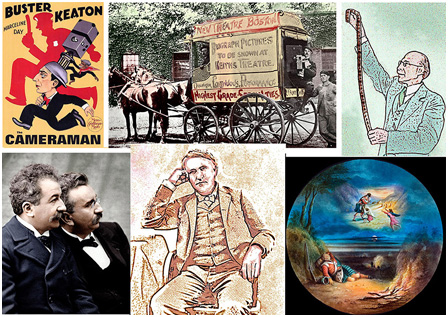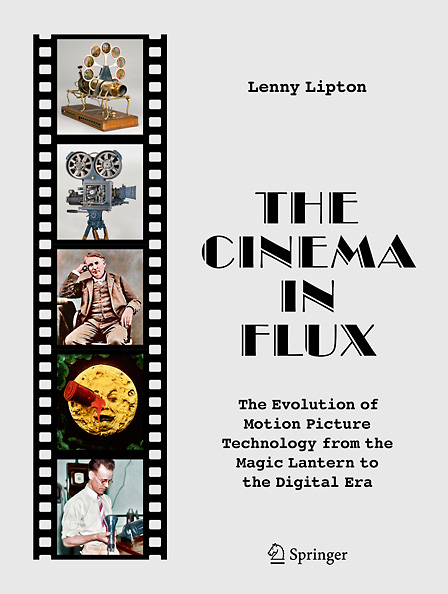‘Cinema’ history nods to UI prof

~~~~~
One of these eons, I might share a few anecdotes about the strangest ways I’ve obtained a remnant or product related to the movies of Champaign, Urbana, and the cities beyond. I take it seriously enough because of how little I’ve found over the two decades we have produced MICRO-FILM and C-U Blogfidential that is not in the form of newspaper articles or event fliers. Each and every piece can help to augment our posts whether it is predictable or one of a kind. Yet, the stories of how I arrive at the stories are often the exact opposite of astonishing. It’s a bit hard in 2021 to get stoked over a relevant listing on eBay I wasn’t expecting, but now at least I can tell you about a new book that notes a local milestone.
The international educational publisher Springer Nature, through its Springer imprint based in Heidelberg, Germany, released in April an impressive volume called The Cinema in Flux: The Evolution of Motion Picture Technology from the Magic Lantern to the Digital Era. Available at Amazon as of yesterday, Tuesday, May 11, the 817-page behemoth is written by the venerated author, filmmaker, and innovator Lenny Lipton, whose research and development led to advancements in stereoscopic imagery such as the RealD three-dimensional projection used in thousands of movie theaters worldwide. Eighty-three chapters trace the development of cinema from its primitive forms of the 1600s to digital adaptions in the present, as stated in a Springer press release from last week, with an effort made to elucidate on the numerous individuals whose work paved the way and their impact on society the world over.
How does it point to the C-U? One of the two men highlighted in Chapter 29, “One Man Bands,” is the late University of Illinois electrical engineering professor Joseph Tykociński-Tykociner (1877-1969). We’ve talked about his sound-on-film development in the past and highlighted it at the New Art Film Festival. The other, an inventor from France named Eugène Augustin Lauste (1857-1935), made various attempts to develop a viable sound-on-film system by working both independently with colleagues in England and Europe and at American companies such as Thomas A. Edison and Bell Laboratories, according to Lipton. It’s nice to see them singled out with recognition instead of a mere mention or two.
~~~~~
~~~~~
Clearly, a very grateful audience will pay $40 per eBook and $55 per hardcover to pour through Lipton’s grasp on technological advancements in the motion picture. Apart from the contextual wealth it is bound to provide researchers, historians, and gear aficionados, The Cinema in Flux is illustrated with nearly 600 pictures – note the Tykociner portrait at the head of our post, cropped from a collage appearing at the author’s website and flanked by Edison and the Lumière brothers – and begins with an introduction from another Hollywood pioneer, Douglas Trumbull, whose influential visual effects are found in the likes of BLADE RUNNER, CLOSE ENCOUNTERS OF THE THIRD KIND, SILENT RUNNING, THE TREE OF LIFE, BRAINSTORM, and – you know I’m obliged to go here – 2001: A SPACE ODYSSEY.
It could easily be argued that Tykociner managed a sort of visual effect with his experiments, presenting subjects on his screen who could actually make noise in real time as they spoke and played instruments. A few years after the NAFF gave its audience a chance to watch an admittedly low-grade copy of the demonstration reel left behind by Tykociner, the National Film Preservation Foundation provided the means to create a much better transfer of the footage and its soundtrack. You can watch the startling results at the UIUC Media Space portal and, if not springing for The Cinema in Flux, view the video short embedded here and read this evergreen article by Bethany Anderson at the University of Illinois Archives website for more on Tykociner’s achievement and legacy.
~ Jason Pankoke
p.s. A different Springer Nature imprint that specializes in the humanities and social sciences, Palgrave Macmillan, is the home of Media Audiences and Identity: Self-Construction in the Fan Experience by Dr. Steven Bailey. It’s the one that dissects the dynamics of localized do-it-yourself culture using, as its case study, the long-gone C-U Freaky Film Festival. Yours truly earned a few mentions in the chapter as well.
~~~~~
